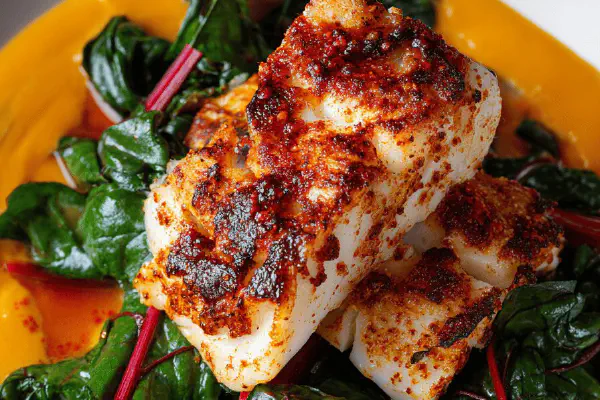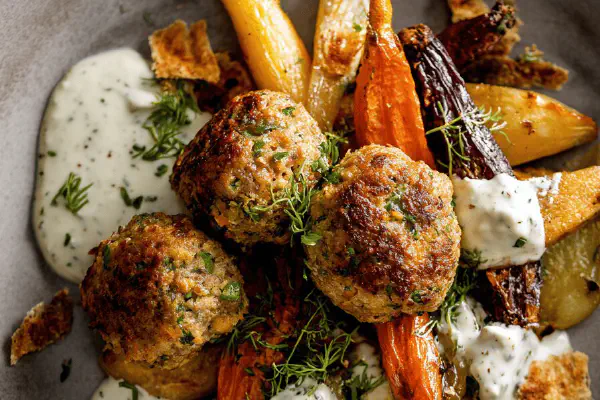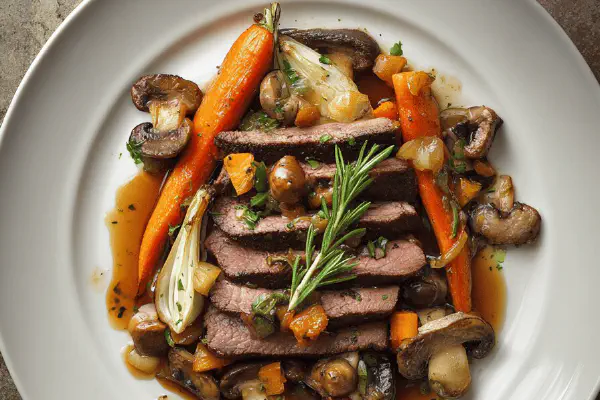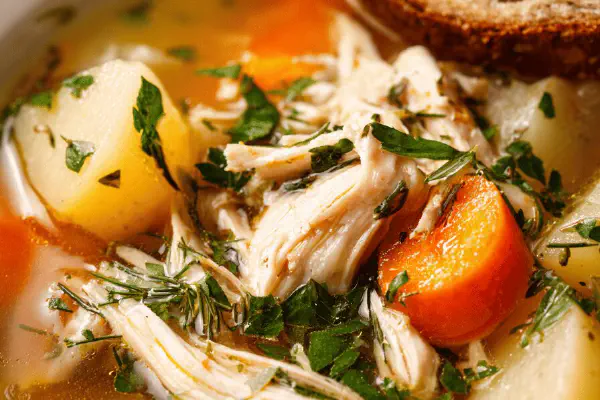Mustard-Crusted Lamb Shoulder
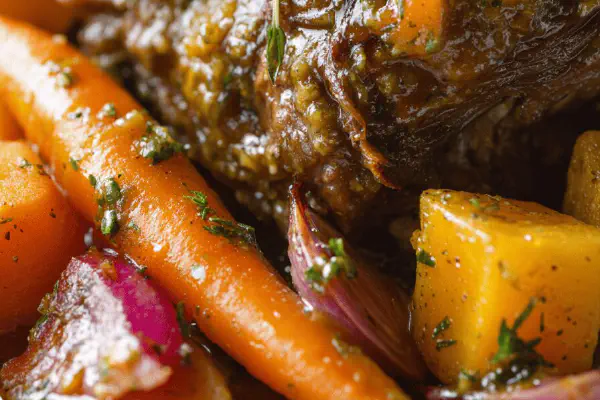
By Emma
Certified Culinary Professional
Ingredients
- 1 leg of lamb shoulder with bone, about 2 kg (4 1/2 lb)
- 25 ml (1 1/2 tbsp) vegetable oil, plus extra for cooking
Marinade
- 1 French shallot, finely chopped
- 2 cloves garlic, minced
- 4 sprigs fresh thyme, leaves only
- 50 ml (3 tbsp) whole grain mustard
- 110 ml (1/2 cup less 1 tbsp) extra virgin olive oil
Vegetable Ragout
- 10 small Nantes carrots, peeled
- 1 medium turnip, peeled and cut into quarters similar size as carrots
- 25 ml (1 1/2 tbsp) olive oil
- 10 ml (2 tsp) dark maple syrup
- 3 bay leaves
- 700 ml (just under 3 cups) water
Persillade
- 12 g (1/3 cup) fresh flat-leaf parsley, finely chopped
- 1 small onion, minced
- 1 clove garlic, minced
- 15 ml (1 tbsp) olive oil
About the ingredients
Method
Lamb Preparation
- Position rack center oven. Preheat to 90°C (195°F). Lower temp; slow roast is key here. Low and patient.
- Season lamb with salt, freshly ground black pepper. Coat it heavily. That crust—needs to bite back.
- Heat 1 1/2 tbsp vegetable oil in heavy skillet over medium-high heat until shimmering. Brown lamb on all sides until deep golden, about 3-4 minutes per face. Browning seals flavor. Don’t skip.
- Rest meat briefly aside on plate while preparing marinade.
Marinade Assembly & Application
- Whisk shallot, garlic, thyme, and mustard in bowl. Add olive oil gradually, whisking to emulsify; silky, glossy finish essential here. Half marinade reserved cold for serving sauce. The other half slathered all over lamb.
- Wrap lamb tightly in heavy-duty aluminium foil; seal edges well to trap juices. Place foil packet in baking dish.
- Cook low 11 to 12 hours—not a rigid timetable; rely on fork test. Meat should be tender, almost falling apart.
- Remove foil last 20 minutes to develop crust from marinade. This step wakes up the surface, adds texture and chew.
Vegetable Ragout
- In large stainless steel or heavy skillet, combine carrots, turnip, olive oil, maple syrup, bay leaves. Salt and pepper the veggies generously.
- Add just enough water to barely cover root vegetables.
- Bring to boil, reduce to medium heat. Simmer until water evaporates completely and veggies become glossy, lightly caramelized. Stir frequently; you want shiny, lacquered roots, not mush.
- Taste; adjust seasoning. Vegetables should be tender but hold shape.
- ***Note: turnip is earthier than celery-rave, adds subtle bitterness and holds up well to syrup's sweetness.
Persillade and Final Assembly
- Mix parsley, onion, garlic, olive oil. Taste, tweak salt.
- Serve lamb hot, sliced or shredded with juices from foil.
- Accompany with glazed root veggies, sprinkling persillade on top.
- Add reserved marinade on side as tangy condiment.
- Fork-pressed lamb; fork works through meat like butter.
- Juices pooled around plate, bright earthy aroma with mustard sharpness.
- Visual: golden crust, vibrant orange carrots, emerald persillade scattered.
- Eat immediately; leftovers better day after, flavors marry.
Cooking tips
Chef's notes
- 💡 Brown lamb well before roasting. The crust forms flavor base; skip searing and marinade can turn flat. Use high heat skillet; sizzling sound vital. Brown all sides evenly; about 3-4 minutes each. Rest after to avoid hot fat splatter when adding marinade. Oil choice matters; vegetable oil handles heat better than olive here.
- 💡 Whisk mustard and olive oil slowly to emulsify. Clumps mean uneven coating, spot burns in oven. Half marinade cold for dipping keeps acidity sharp, other half coats lamb heavily. Emulsify until glossy; look for silky texture, no grainy mustard bits. Use whole grain mustard for texture contrast and rustic mouthfeel. Dijon burns too fast, avoid if slow roasting.
- 💡 Wrap lamb airtight in foil, seal tightly. Foil traps steam, keeps meat juicy over 11-12 hour roast at low 90°C. Without, surface dries quickly, edges toughen. Keep foil tight; test sealing edges carefully before placing in baking dish. Don’t unwrap too early or juices escape, ruining crust potential. Last 20 mins, peel back foil to crisp surface without drying meat interior.
- 💡 Vegetable ragout: carrots and turnip chosen for texture under long slow simmer. Add just enough water to cover roots barely. Too much water equals mush; evaporate to glossy caramelized finish. Stir often; listen for subtle reduction sounds, liquid should disappear slowly. Maple syrup adds sweet contrast but burns easily. Watch color; deep brown means overheat. Salt generously to punch through syrup’s sweetness.
- 💡 Persillade is raw, fresh finish. Rough chop parsley, onion, garlic to retain texture. Mix with olive oil just before serving, don’t rush or herb flavor dulls. Adds punch and balance to fatty lamb. Sprinkle last moment over veggies and meat. Reserved marinade drizzled on side cuts fat, adds brightness. Use tactile cues—herb aroma sharp, garnished look vibrant green; trust senses.
Common questions
How do I know when lamb is done?
Not time on clock. Fork test is key. Meat should yield with slight resistance then pull. Should be tender but hold shape. If fork slides through like butter, don’t overcook or it’ll dry. Slow roast low temp means patience. Foil sealed keeps jus inside.
Can I replace turnip with celery root?
Yes, celery root softer, less earthy. Turnip gives bite and holds shape better with syrup glaze. Swap olive oil for butter if not dairy-sensitive. Adapt salt and cooking time slightly; celery root easier to overcook, watch caramelization closely.
What if my marinade clumps?
Whisk longer slowly adding oil or use blender. Clumps burn on lamb surface, bitter bits. Whole grain mustard is textured; stir enough to break lumps, preserve seeds. Cold ingredients slow emulsification, bring to room temp. Don’t skip resting lamb after browning; hot fat can break marinade.
How to store leftovers?
Cool quickly, store in airtight container. Keep lamb juices separate or with meat. Veggies reheat gently to avoid turning mushy. Use within 48 hours or freeze. Warm edges reheat unevenly; best to slice before storage. Flavors meld better next day but lose crust crunch.
